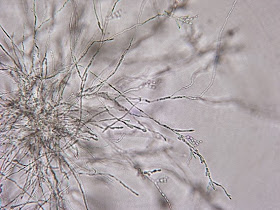Chrysonilia sitophila -Hyphomycetes (formerly Monilia sitophila)
Ecology:
Chrysonilia
species are a cosmopolitan (widespread) saprobe (lives of dead or decaying
plant matter). Chrysonilia may be found within the home as ‘red bread mould’,
named for the colour of growth found on contaminated bread. Chrysonilia
is the asexual state (anamorph) of Neurospora,
its sexual or (teleomorph) state. Neurospora’s ascospores are stimulated by
applied heat and therefore Neurospora
and the Chrysonilia anamorph may be
the first organisms to repopulate areas devastated by grass or forest
fires. For the same reason, it is notorious for
populating heat sterilized soils such as those found in greenhouses. Chrysonilia’s
teleomorph, Neurospora, is frequently
used in the study of genetics and basic eukaryotic cell biology because of its
desirable growth characteristics.
Chrysonilia
sitophila was formerly called Monilia
sitophila; however the genus Monilia
now only encompasses plant pathogens.
Pathogenicity:
Chrysonilia is
considered to be a contaminant and is not considered to be very
pathogenic. It has been implicated in
peritonitis, eye infections as well as occupational asthma.
Macroscopic Morphology:
·
Colonies exhibit extremely rapid growth,
maturing within 72 hours.
·
Colonies can range in colour from white to a
pale pink, a salmon colour to light orange.
·
Texture is very cottony which quickly fills the
petrie dish, often referred to as a “lid-lifter” as it crawls up the sides of
the dish and presses against the lid.
Chrysonilia sitophila - 24 Hours growth on SAB agar plate incubated at 30˚C (Nikon)
Chrysonilia sitophila - This composite shows how quickly this fungus grows. Within one day the centrally inoculated plate has been filled with the mycelium. By 4 hours it has already completely filled the standard petrie dish and the areal hyphae are pushing against the lid. By day three, the slight pinkish to salmon to light-orange colour, characteristic of this fungus is evident. After a week the growth may have collapsed back on itself and be even be trying to crawl out the sides of the petrie dish. This organism is notorious for contaminating laboratories with the multitude of spores (conidia) produced. (Nikon)
Microscopic Morphology:
·
Chrysonilia produces smooth-walled, hyaline,
septate hyphae.
Sources differ on their description of the conidia
produced. The majority of sources I
consulted only mention rectangular ‘arthroconida’, produced as the hyphae disarticulate
or break-up. Yet another source mentions
blastoconidia in addition to the arthroconidia.
By definition these should emerge as a bud which is then cleaved off at
maturity, often leaving a mark or scar at the point of attachment. I have pointed these out where I believe they
match the description.
·
Simple, poorly differentiated conidiophores can
be single or branched.
·
Conidiophores produce branching chains of oval
conidia (5-10 µm X 10-15 µm)
·
Mature hyphae break up forming thick-walled
rectangular arthroconidia connected by disjunctors.
Chrysonilia sitophila -a first look at low magnification.
(100X, LPCB, DMD-108)
Chrysonilia sitophila -septate hyphae are seen with poorly differentiated conidiophores producing chains of rather round blastoconidia. Rectangular arthroconidia are also evident, produced as the hyphae fragment or disarticulate.
(400X, LPCB, DMD-108)
Chrysonilia sitophila - another view as above.
(400X, LPCB, DMD-108)
Chrysonilia sitophila -and another. The rather round Blastoconidia (Bc) are being produced in addition to the rectangular Arthroconidia (Ac). Are the so called 'Blastoconidia' referring to immature or developing arthrospores in one source? The blastoconidum shown clearly does not appear to be the product of a fragmenting hyphal element. The hyphae are septate (S), along the lines where they will disarticulate into separate arthroconidia,
(400X, LPCB, DMD-108)
Chrysonilia sitophila -Branching hyphae & conidiophores.
(400X, LPCB, DMD-108)
Chrysonilia sitophila -ditto
(400X, LPCB, DMD-108)
Chrysonilia sitophila -whether these are considered to be blastoconidia or immature arthroconidia, chains are clearly shown to be developing from a branch extending from a main hyphal element.
(400X, LPCB, 400X)
Chrysonilia sitophila -arthroconidia can be seen joined to each other via a disjunctor cell (Dj) which appears as a small bridge separating one cell from the next. Various texts show the disjunctor as being more pronounced than seen here.
(1000X, LPCB, DMD-108)
The photograph show above, as several of the previous, are taken from an adhesive tape preparation. I have found at times that an adhesive tape preparation preserves features better than a slide culture and sometimes the opposite. Use whatever technique works best for you. Overall, I like slide cultures as it generally produces a much clearer photograph. In tape preps such as this, you can often detect the unevenness of tape surface and distribution of the adhesive. Here the background is full of bubbles from trapped air and the adhesive.
Chrysonilia sitophila -hyphae disarticulating into arthrospores (AC).
(1000X, LPCB, 1000X)
Chrysonilia sitophila -once again, it appears to me that there is a distinct difference between the blastoconidia (BC) which often appear to develop from the side of the hyphae or rudimentary conidiophore and those of the already rather rectangular arthrospores at the apex of a fragmenting hyphal element. (Dj = Disjunctor)
(1000+10X, LPCB, DMD-108)
Chrysonilia sitophila - One last photo again showing what I call a round blastoconidium (BC) on a very basic conidiophore (Cp). To my eye, these look distinctly different from the rectangular arthrospores forming by the disarticulation of the hyphae which they originate.
(1000+10X, LPCB, DMD-108)
Physiological Tests:
·
+Growth at 37˚C.
·
+Growth on Cycloheximide Agar
* * *


.jpg)










































